Charles Elcock, 1834 - 1910
by Brian Stevenson
last updated August, 2014
Charles Elcock
was a professional microscope slide maker, operating from Belfast, Ireland
between ca. 1880 and the first decade of the 20th century. Elcock specialized
in mounting foraminifera, producing slides that are both scientifically useful and
aesthetically pleasing.
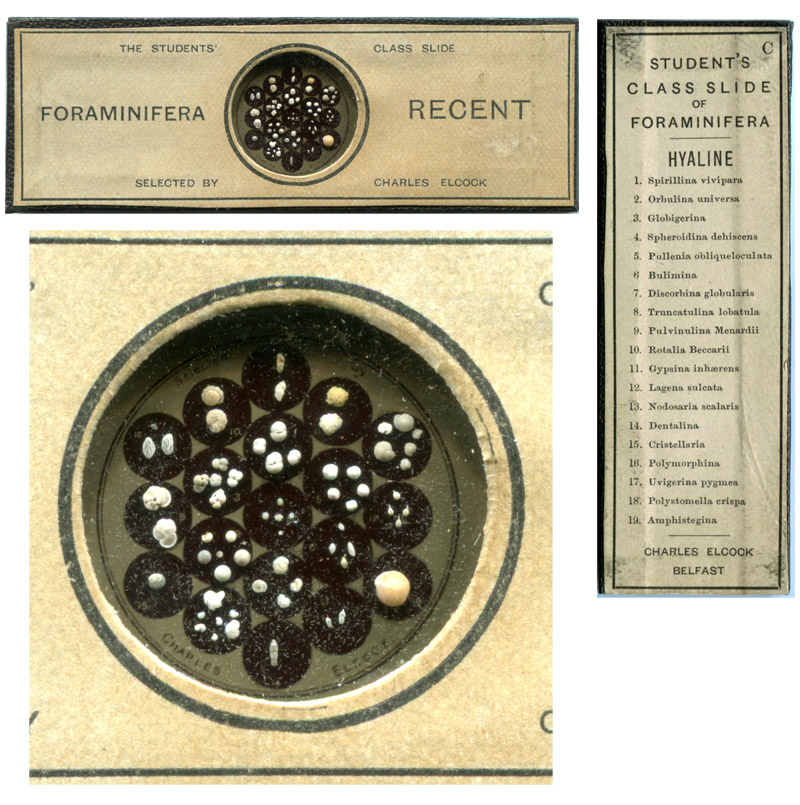
Figure 1.
A Charles Elcock “Student Class Slide”, prepared for
sale. The specimens are dry-mounted in a symmetrical array. A list of the
specimens is pasted onto the slide’s reverse. Such slides are made of thick
cardboard, approximately 1/8 inch thick, with printed papers applied to the front
and back.
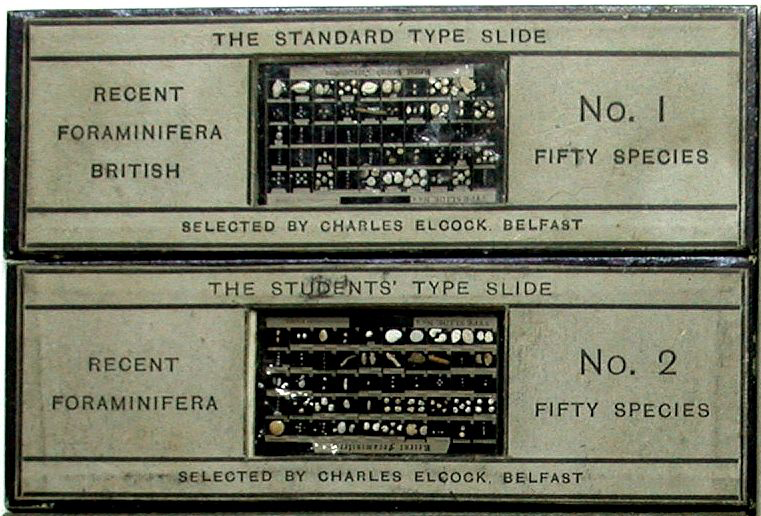
Figure 2.
Two Elcock “Type Slides” of foraminifera, prepared
for sale. The specimens are identified on the reverse. Adapted by permission
from http://www.victorianmicroscopeslides.com/slidemar.htm

Figure 3.
An early microscope slide by Charles Elcock, dated September 17, 1880. Mounted on wood with a taped-on cover slip. The crudeness of preparation suggests that it was not intended for sale. Adapted for
educational, nonprofit use from http://www.nhm.ac.uk/natureplus/blogs/micropalaeo/tags/foraminifera
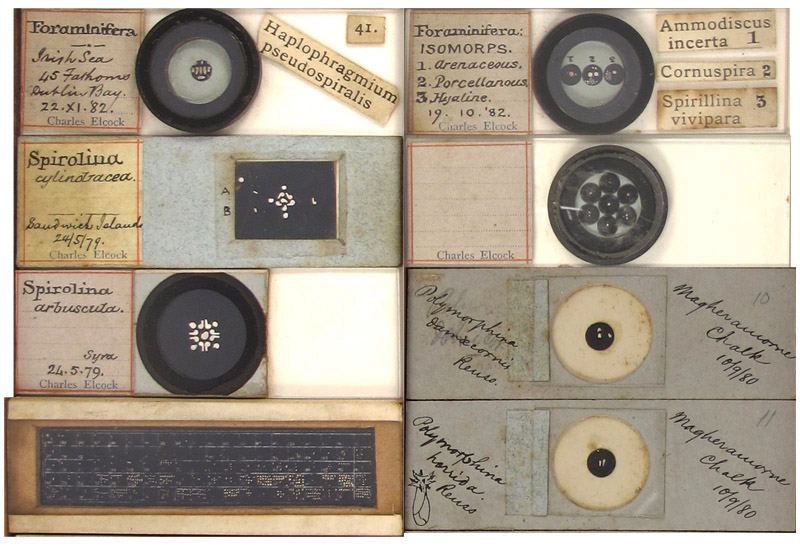
Figure 4A.
Additional slides by Charles Elcock, from his personal collection. These were presumably for his own study, although some may have been commercial preparations in progress.
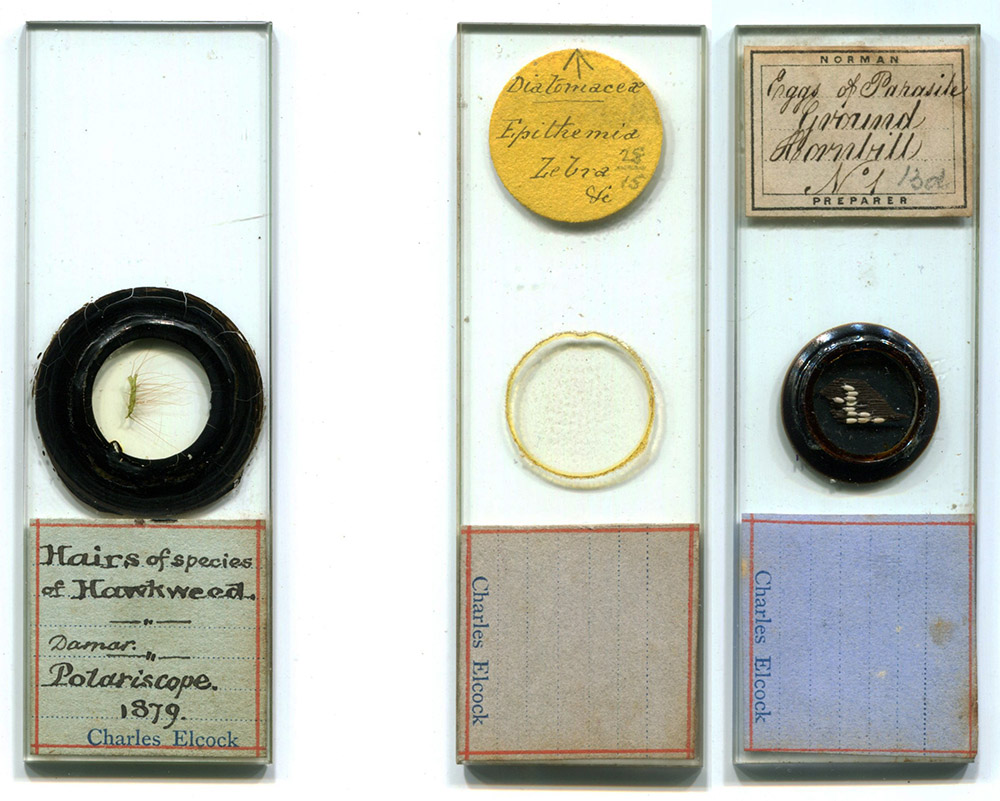
Figure 4B.
Additional slides from Charles Elcock's collection. (Right) "Hairs from a species of hookweed" mounted by Elcock in 1879. (Left) Two slides by other mounters.
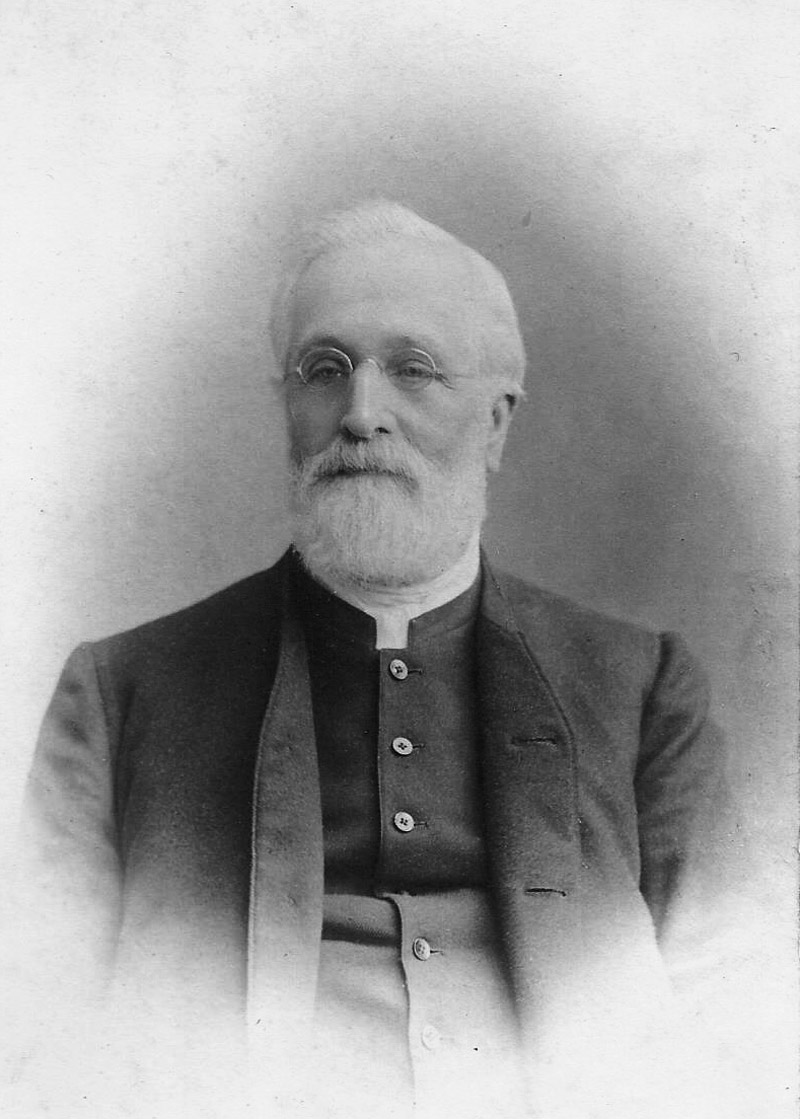
Figure 5.
Charles Elcock. An obituary featured this same
photograph, so it was presumably taken near the end of his life.
Charles
was born in Pontefract, Yorkshire, England, on August 18, 1834, the second son
of Charles and Mary Ann Elcock. The father was a printer and book publisher.
Originally from Surrey, Charles Sr. had also operated a publishing business in
Yarmouth, Norfolk. The Elcocks were members of the Society of Friends
(Quakers). The wedding of Charles Sr. and Mary Ann caused them to be alienated
from the church, as the ceremony was performed by a professional cleric. They
seem to have still been associated with the Quakers to some extent, since later
lists of books produced by church members included the publications of Charles
Sr., along with a note that “he was
disowned for being married by a priest”. Whatever their formal connections
to the Quaker denomination, the Elcocks evidently persisted in following its
beliefs – Charles Jr. wrote numerous articles and books on Quaker doctrines,
and participated in war relief missionary work.
The father
died in 1837, at the age of only 42. Mary Ann took work as a school teacher. Nonetheless,
the family was sufficiently well off that Charles could go to the Friends’
School at Rawdon from 1842-1848. The 1851 census recorded that the 16 year-old
Charles was back in Pontefract but boarding away from his family and working as
a printer. He then took teaching jobs, first in Wigton, Cumbria from 1852-1856,
then Penketh, Lancashire from 1860-1862. The 1861 census listed Charles as a
teacher at the Stocks Lane Quaker Boarding School, in Pontefract, which may
have been between terms for Penketh.
Shortly
thereafter, Elcock returned to writing and printing. From a list of Quaker
writers and publishers, it is evident that Charles worked in London around
1864, and in Gloucester by 1866. In London, he published with (and probably
worked for) Alfred William Bennett. A.W. Bennett was a member of the Royal
Microscopical Society, a member of the RMS Publication Committee and an editor
of Nature. It is likely that Charles’
association with Bennett led to or enhanced his interest in microscopy. Bennett
was also a Quaker. In Gloucester, Elcock worked with John Bellows at his Steam
Press. Bellows was likewise a Quaker.
Elcock’s books were primarily religious. Between 1864 and 1867, they included A Plea for Christian Doctrine, Remarks on the Impropriety of Calling the Holy Scriptures "The Word of God", A Few Words about the Quakers and their Principles, and A Perpetual Calendar (for any Year between 1 and 4099, with a Table showing all the First Days of the Week in any Year.
Elcock’s
belief in Quaker principles were put into action during the Franco-Prussian
War, when he journeyed to France to bring aid to refugees. Among other acts, in
December, 1870, he convoyed 59 cases of clothing to the French town of Metz,
which was then occupied by the Prussian army. Further details are provided by
John Bellows, who was also there and wrote of the situation in his The Track of the War Around Metz: And The
Fund for the Non-combatant Sufferers. Some excerpts from late 1870-early
1871: “Charles Elcock arrived tonight. He had a frightfully stormy passage to Antwerp, during
which they saw a ship go down with all hands on board”, “Charles Elcock, like
myself, has been travelling with a bearer of dispatches - this time from the
Queen to Odo Russell. After passing Luxembourg, the messenger put on the
uniform of a British army captain, and a garter badge.”, “I have been, with Emilia de Bunsen and C. Elcock, nearly an hour with Count Henckel-Donnersmark, today.
He has accorded everything we ask him. The weather is getting milder, and rain
coming on”, “Charles Elcock and Thomas Whitwell at the office today. Among the
persons calling, was a lady whose husband owns considerable property near
Gravelotte. One of his chateaux, called Ay, was made into an ambulance by the
Germans. They kept one room for an amputating room; and as they never took the
trouble to bury the arms and legs that were cut off, but threw them into an
adjoining room, the whole mass, and the blood, has been rotting there until it
is impossible to approach the place! A fever is raging all round Ay”, “Charles Elcock and
Thomas Whitwell go to the large ironworks at Ars-sur-Moselle, where we were
last week, to make a more diligent scrutiny as to the present state of the
people, the accounts being so conflicting that we do not know what to trust to”,
and “Samuel Gurney and Charles Elcock have been today to a village called Chesny, where
Charles has taken a sketch. The general state of things is not bad in that
quarter - but they met with a man who had begged a loaf of bread from Charles
and me the day before; and they found he had been occupying before the war a
house not far short of the size of Acton
Hall. At the outbreak of hostilities he had taken refuge in Metz, and
remained in the city all the time of the siege, leaving his house to the mercy
of the Prussians. When he got back he found every stick of furniture burnt,
every window and door clean gone, and the floors torn up, the planks having
been removed for firing”,.
By 1873,
Elcock was back in England and living in Manchester. He published another book,
What is the Gospel?, giving his
address as 71 Market Street.
He also
became involved with a scheme to both clean city streets and treat human
sewage. He presented his plans to the 1874 Meeting of the British Association
for the Advancement of Science, in a talk entitled, “On a new method for promoting the sanification of our cities”. Elcock
also provided details in an article for The
Journal of the Society of Arts. The sanitation scheme involved collecting
street sweepings (i.e. horse manure) and garbage, burning them to charcoal,
mixing human sewage with the charcoal to deodorize it, then using the mixture
as fertilizer for crops. The Journal of the Society of Arts
article listed Elcock as being the Secretary of the Universal Charcoal Company
and gave his address as 71 Market St., Manchester. On March 4, 1875, a patent
was issued to, “Charles
Elcock, of the city of
Manchester, for an invention of an artificial animal charcoal suitable as a
filtering, decolorising, and deodorising agent, and for forming into blocks for
various purposes".
Available
Irish records state that Charles married Harriett Sophia Green in Belfast during
1876, but do provide the date or other details. Genealogical information
indicates that Harriett was born in Ireland in 1843, which would explain the
Irish wedding. Noting that the 1874 meeting of the British Association was held
in Belfast, it is possible that Charles and Harriett met during his trip. Yet the
couple evidently lived in England for some time after the wedding. Charles
wrote a letter to The British Friend in
July, 1876 that was addressed from 19 Clarence Street, Chorlton-upon-Medlock,
Manchester. In April, 1877, he presented a talk to the Dublin Friends’
Institute, but gave his home address as Manchester. The Elcocks’ move to
Ireland appears to have been incremental, possibly with homes in both
locations. The list of members of the Belfast Naturalists’ Field Club indicates
that Charles became a member during the year that ended March 31, 1877, and
gave his address as Fitzroy Avenue. Their first child, Catherine Emily Elcock,
was born on July 1, 1877, in Belfast. I have not located any references of
Elcock giving an address outside Ireland after April, 1877, so it appears that
he was firmly rooted in Belfast by late spring of 1877.
As noted
above, Charles Elcock joined the Belfast Naturalists’ Field Club upon his move
to that city, possibly before he was even settled in. Club proceedings from
1879 note that Elcock then possessed fine skills at mounting arrangements of
foraminifera on microscope slides, “Several
Collections were sent in by members in competition for some of the prizes
offered by the Club. The Judges appointed to make the awards report as follows,
‘We have examined the twenty-five Microscopic Slides submitted by Mr. Charles
Elcock in competition for Prize 14. We are of opinion that the collection is
strictly in accordance with the conditions. The mounted objects are chiefly of
Foraminifera, illustrated by a great variety of species, and several excellent
methods of mounting. All are prepared with artistic skill and superior finish.
We recommend that the prize be awarded to Mr. Elcock’.”
Elcock’s
occupation during his early years in Ireland is not currently known. The only
clue I have unearthed is an 1880 street directory of Belfast, which described Charles Elcock of 48 Fitzroy Avenue being a “clerk”.
Charles
was listed as a member of the Postal Microscopical Club in the first issue of
their Journal, which implied that he had
been a member since the club’s founding in the mid-1870s. The club’s member
list indicated a relocation of the Elcock household between 1880 and 1882, to
10 Dunluce Street, Belfast.
Elcock
wrote two extensive articles on “How to
prepare foraminifera” for the inaugural volume of The Journal of the Postal
Microscopical Society. He also
published an advertisement for his type slides of foraminifera, asking 20
shillings per slide (Figure 6). He already had a distribution network
established in England, with well-regarded retailers in London, Manchester and
Bath. A review of his work in the journal stated, “These Slides are marvels of manipulative skill. Each slide contains 50
species, neatly arranged in squares, with the name of each species photographed
in good readable type above its respective shell. A clearly-printed and
arranged Catalogue accompanies each slide to assist in the finding of any
special form, should that be necessary. As each species is represented in most
cases by two or three specimens mounted front, back, and side-view, we consider
that these Slides ought to be in the hands of every student of the
Foraminifera; and for our own part can only say that we should not like to
prepare them for twice the price at which they are sold”. While one cannot
deny the high quality of Elcock’s microscope slides, in fairness it must be noted that the editor of The Journal of the Postal Microscopical Society was Alfred Allen, who also sold Elcock’s slides.
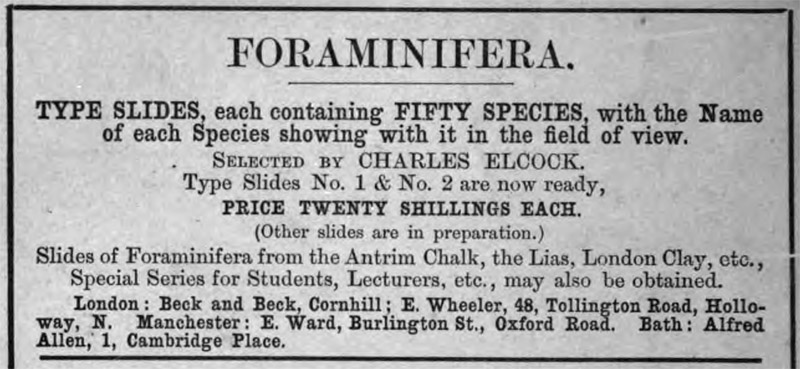
Figure 6.
Advertisement by Charles Elcock, from an 1880 issue
of The Journal of the Postal Microscopical Club.
The
Elcocks moved again during 1882-83, that session’s membership list of the Belfast Naturalists' Field Club recording
Charles’ address as Hughenden Terrace, Cavehill Road. Charles’ 1884 “Note on the occurrence of some rare foraminifera in
the Irish Sea”, published in The
Annals and Magazine of Natural History, gave his address as 19 Hughenden
Avenue, Belfast.
Producing
microscope slides was evidently a major source of income for the Elcocks. A 1901
street directory of Belfast listed Charles’ profession as “microscopist”. He travelled to promote his productions, such as was
reported for his 1885 visit to the Birmingham Natural History and Microscopical
Society, “Mr. Chas. Elcock, of Belfast, exhibited seven type slides of
foraminifera - two of fifty different species each, four of different species
each, of different orders - Miliolidae,
Hyaline, Porcellanous, and Lagena; one of thirteen different species of the Arenaceous order; and several species of living foraminifera”.
Charles
maintained his devotion to Quaker doctrine, publishing several lengthy articles
and at least one book from Ireland. These included Does the Holy Spirit enlighten, condemn, cleanse, sanctify, and
justify?, Keep all your meetings in
the power of God, and a book that severely challenged the beliefs of an
American branch of the Friends, The
Confessions of Non-belief Issued by the Binn’s Select Yearly Meeting of Ohio
Examined.
In
addition, Elcock had a strong interest in archaeology, joining the Royal Historical and Archaeological Association
of Ireland in 1889. A few years earlier, in 1884, he had presented an extensive
talk to the Belfast Naturalists' Field Club on "Antiquities in Mayo, Galway, and the Aran Islands". He illustrated that talk with “a large number of rubbings and tracings of
monumental antiquities”. Elcock’s sketchbook from an 1883 trip to Aran and
Galway has recently come to light, and several pages of sketches and notes are
shown at the end of this essay as Figure 10.
In 1896, The Irish Naturalist, reported that, “Mr. Charles Elcock, long a member of the
Belfast Field Club, and a microscopical manipulator of great skill, has been
appointed Curator of the Art Gallery and Museum at the Free Public Library in
Belfast, in place of Mr. J.F. Johnson, whose recent mysterious disappearance
caused some sensation locally”. Elcock resigned from that position in
March, 1905.
The June,
1910 issue of the Belfast Municipal Art Gallery and Museum’s Quarterly Notes reported, “We regret to announce the death of a former
curator, Mr. Charles Elcock, at his residence, 19 Hughenden Avenue, Belfast, on
February 10th last. Mr. Elcock, who was born in 1834 at Pontefract, in
Yorkshire, was the son of a printer and publisher of that town, and was
destined at first to follow the trade of his father, having been in the service
of various publishing firms in Gloucester, Bristol, and London. Afterwards,
however, he took up the profession of teaching, and was engaged at Penketh,
near Warrington, a school under the management of the Society of Friends. On
the 13th August, 1896, Mr. Elcock was appointed Curator of the Belfast
Municipal Art Gallery and Museum, and severed his connection with the post on
the 31st March, 1905. He was remarkable for his versatility, but was best known
for his contributions to the study of Foraminifera, and was regarded as one of
the most skilful manipulators at the selection, mounting, and identification of
these small organisms, samples of the ‘Challenger Deep-Sea Dredging Expedition’
being forwarded to him for examination. Mr. Elcock took a keen interest in
Irish Antiquities. He contributed articles to the Journal of the Royal Society
of Antiquaries, and delivered several papers to the Belfast Naturalists' Field
Club. He was buried on the 14th February last at the Friends' Burial-ground at
Hillsborough, Co. Down.”
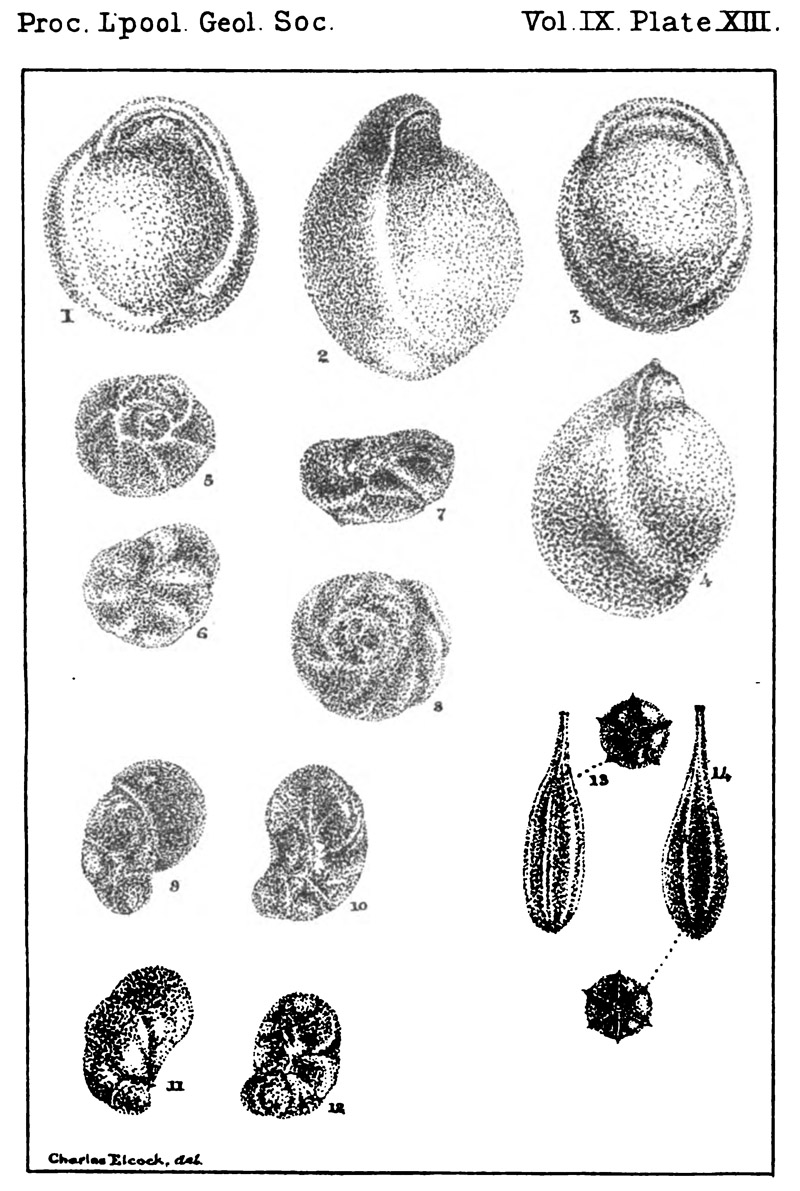
Figure 7.
Engravings of foraminifera, by Charles Elcock. From
The Proceedings of the Liverpool
Geological Society, 1901.
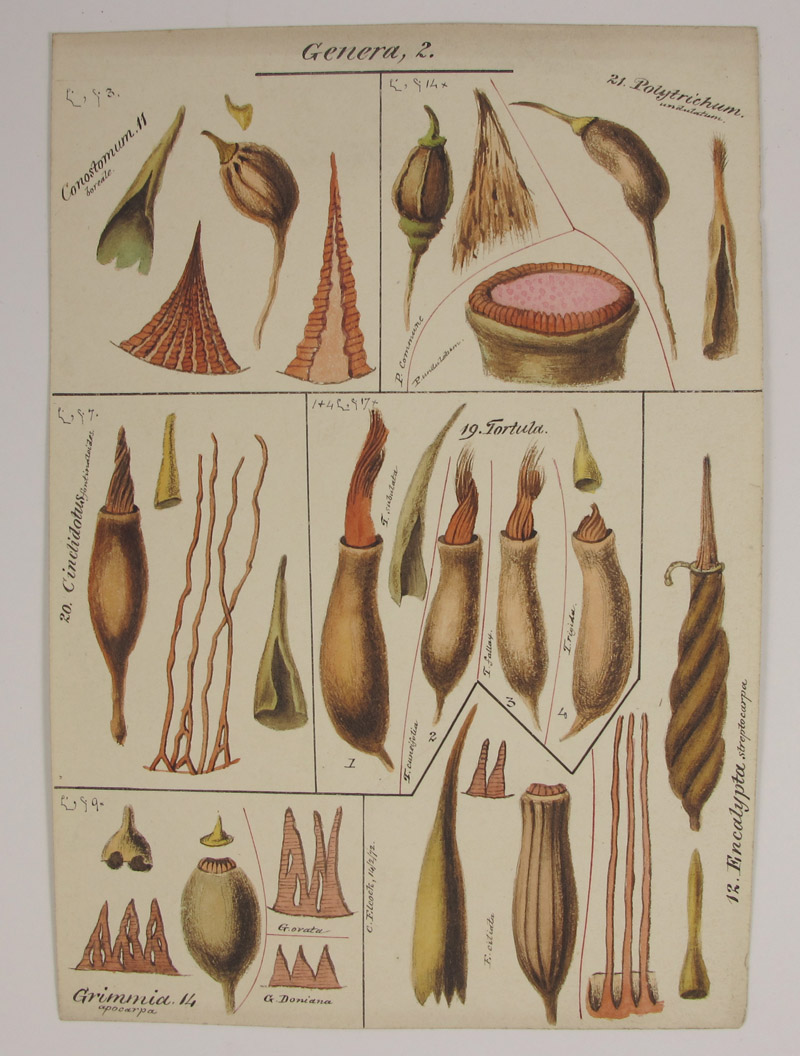
Figure 8.
Charles Elcock had interests in nature and
microscopy beyond foraminifera. Shown are sketches by Elcock of moss spores.
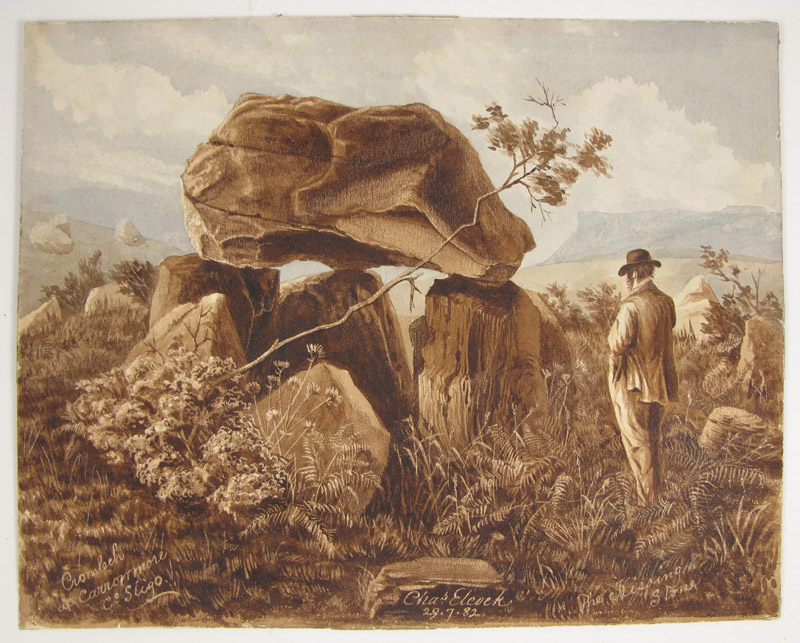
Figure 9.
An 1882 watercolor by Charles Elcock.
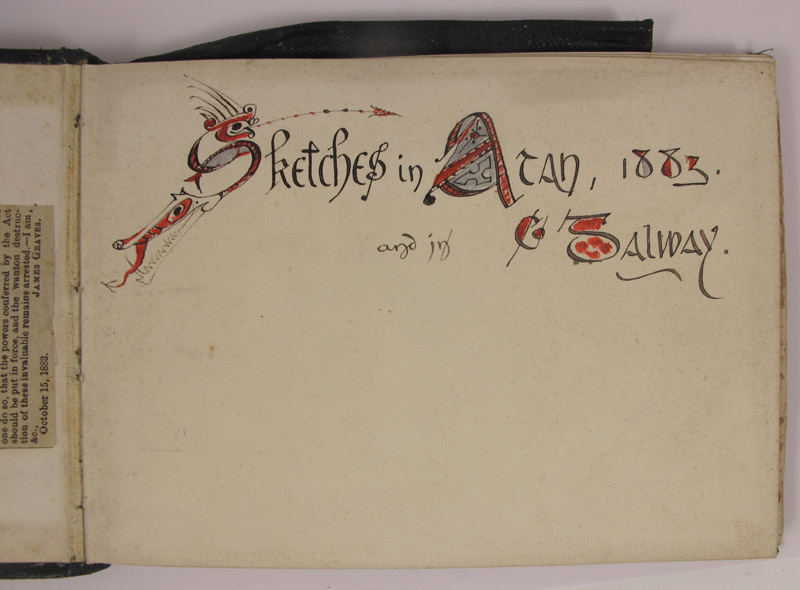
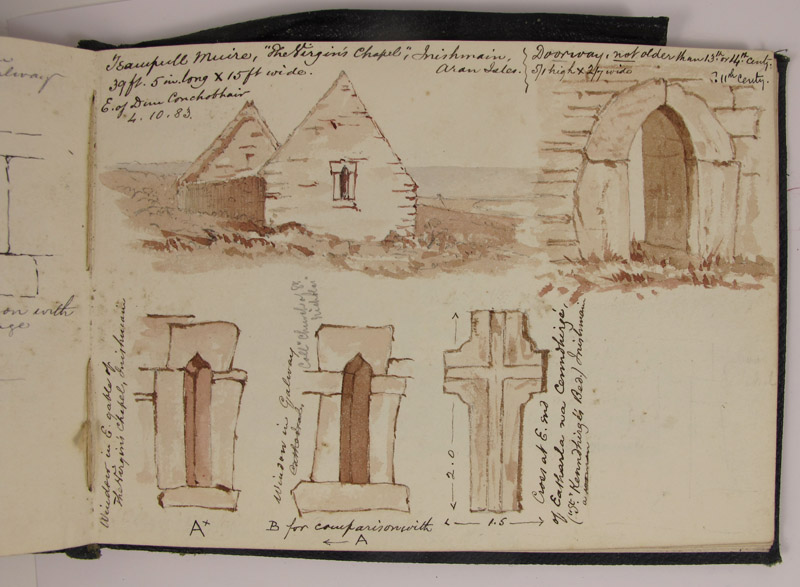
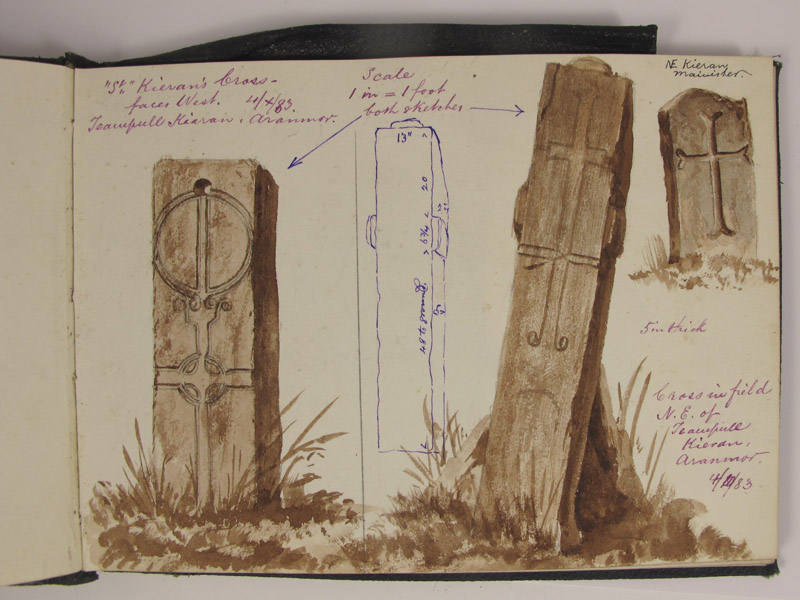
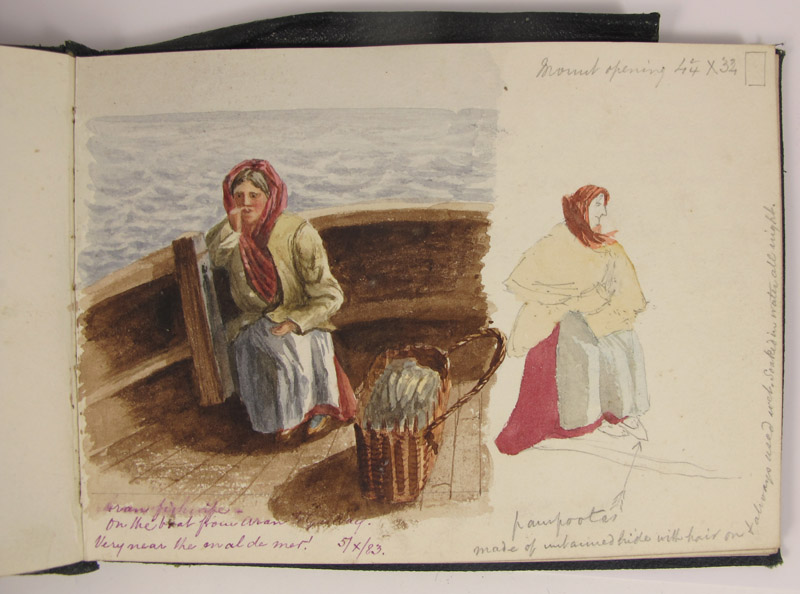
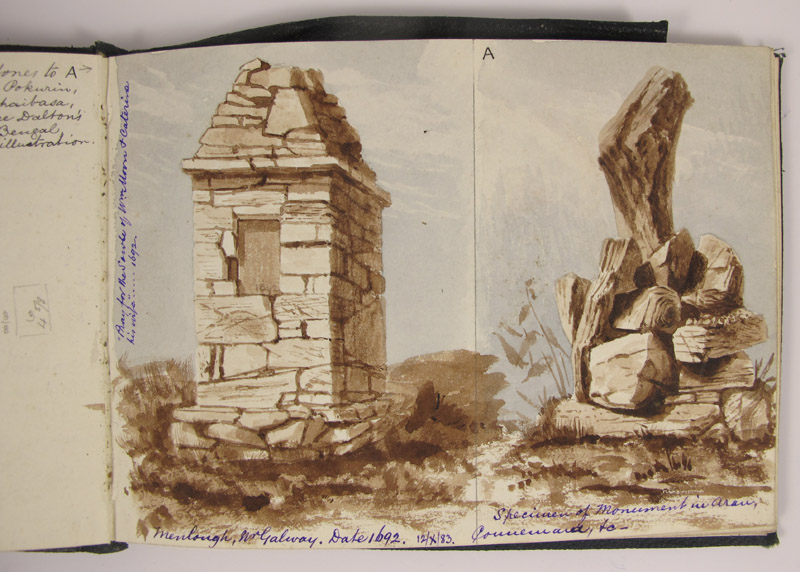
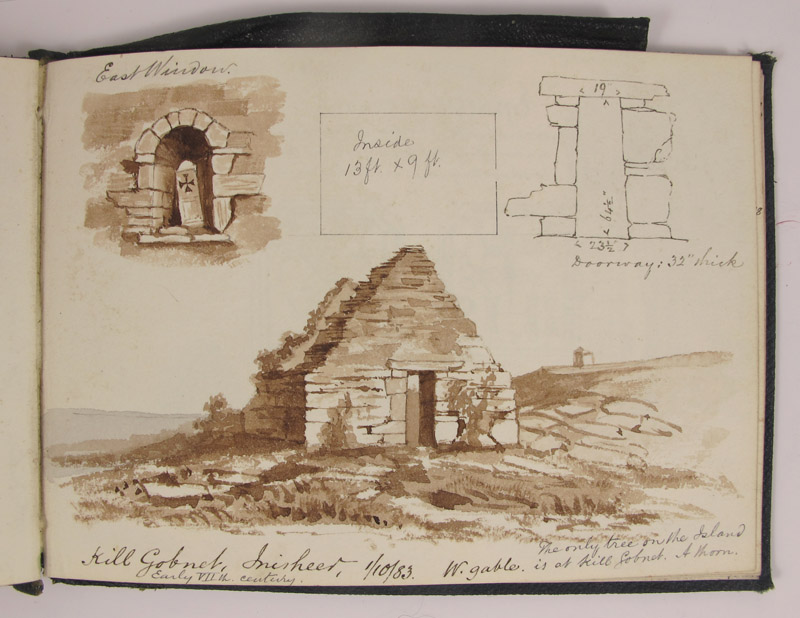
Figure 10.
Excerpts from Charles Elcock’s 1883 sketchbook of
Aran and Galway.
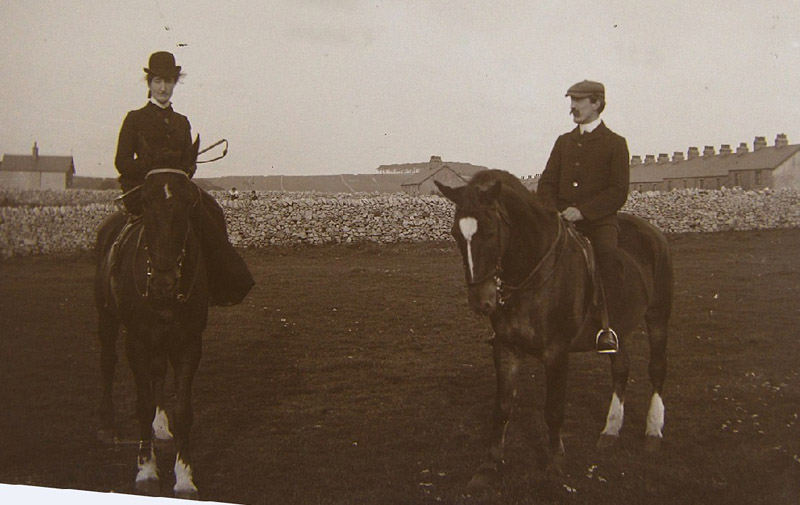
Figure 11.
An undated photograph of Charles Elcock.
Acknowledgements
Many thanks to Peter Hodds, Richard Courtiour and Howard
Lynk for sharing images and information.
Resources
Annual Report and Proceedings of the Belfast Naturalists' Field Club (1876) Membership list for the year ending March 31, 1876, which
indicates that Charles Elcock was not yet a member
Annual Report and Proceedings of the Belfast Naturalists' Field Club (1877) Membership list for the year ending March 31, 1877: “Charles Elcock, Fitzroy Ave”, page 278
Annual Report and Proceedings of the Belfast Naturalists' Field Club (1879) Winter session, page 383
Annual Report and Proceedings of the Belfast Naturalists' Field Club (1880) Membership list for the year ending March 31, 1880: “Charles Elcock, Fitzroy Ave”, page 370
Annual Report and Proceedings of the Belfast Naturalists' Field Club (1881) Membership list for the year ending March 31, 1881: “Charles Elcock, Dunluce Ave”, page 442
Annual Report and Proceedings of the Belfast Naturalists' Field Club (1883) Membership list for the year ending March 31, 1883: “Charles Elcock, Hughenden Terrace, Cavehill Road”,
Annual Report and Proceedings of the Belfast Naturalists' Field Club (1884) Report of Charles Elcock’s lecture on “Antiquities in Mayo, Galway, and
the Aran Islands”, page 248-251
Belfast Street Directory (1877) Charles Elcock not
listed,
http://www.lennonwylie.co.uk/BSD1877.htm
Belfast Street Directory (1880) “Fitzroy
Avenue, 48 Elcock, Charles, clerk”, http://www.lennonwylie.co.uk/1880_henry.htm
Belfast Street Directory (1901) “Elcock, C., microscopist and curator, Belfast Free
Public Library, Art Gallery, and Museum; res., 19 Hughenden Avenue”, http://www.lennonwylie.co.uk/alphanames1901DE.htm
Belfast Street Directory (1907) “Elcock, C., microscopist, 19 Hughenden
Avenue”, http://www.lennonwylie.co.uk/alphanames1907DE.htm
Bellows, John (1871) The
Track of the War Around Metz: And The Fund for the Non-combatant Sufferers,
second edition, Trübner, London, pages 53, 54, 55, 63, 64, 65
Birth record of Catherine Emily Elcock (1877)
http://www.sinton-family-trees.com/ft_main.php?rin=5085
Bracegirdle, Brian (1998) Microscopical Mounts and Mounters, Quekett Microscopical Club,
London, pages 34 and 192 and Plate 44
The British Friend (1875)
Notices of meetings: “10th Month, Manchester
Friends’ Institute, 4th, ‘Miniature Poetry, with illustrations, by
Charles Elcock”, Vol. 33, page 254
The British Friend (1877)
Notices of meetings: “Dublin Friends’
Institute, Fourth Month, 19th. Bunyan’s Pilgrim’s Progress: is it original?
Expected to be read by C. Elcock, Manchester Friends’ Institute”, Vol. 35,
page 94
The British Friend (1878) “Ninth Month, 1878, Elcock - 29th. At 48
Fitzroy Avenue, Belfast, Harriet Sophia, wife of Charles Elcock, a son, who was
named Charles Ernest”, Vol. 36, page 298
The British Friend (1882) “Tenth Month, Elcock - 2nd. At 10 Dunluce Street, Belfast, Harriet
Sophia, wife of Charles Elcock, a daughter who was named Harriet Mabel”, Vol. 40, page 289
A Cabinet of Curiosities (accessed
August, 2014) Examples of Charles Elcock’s microscope slides,
http://www.victorianmicroscopeslides.com/slidemar.htm
Charity, Kate and Malcolm J. Watkins (1993) A Many-sided
Man: John Bellows of Gloucester, 1831 to 1902: Quaker Printer, Lexicographer
and Archaeologist: His Life and Letters, W. Sessions
The Commissioners of
Patents Journal (1875) “807,
4th March, 1875, Charles Elcock, of the city of
Manchester, for an invention of "An artificial animal charcoal suitable as
a filtering, decolorising, and deodorising agent, and for forming into blocks
for various purposes", page 520
Elcock, Charles (1873) What
is Gospel?, W. Irwin, Manchester
Elcock, Charles (1874) Universal Charcoal and Sewage Company
for the utilisation of town’s refuse, Journal of the Society of Arts, Vol. 23, page 66
Elcock, Charles (1876) Smaller
Bunhill Fields Cemetery, The British
Friend, Vol. 33, page 230
Elcock, Charles (1878) Does the
Holy Spirit enlighten, condemn, cleanse, sanctify, and justify?, The
British Friend, Vol. 36, pages 65-67 and 77-79
Elcock, Charles (1882) How to
prepare foraminifera (in two parts), Journal
of the Postal Microscopical Society, Vol. 1, pages 25-29 and 139-145
Elcock, Charles (1878) Keep all
your meetings in the power of God, The British Friend, Vol. 40, page 164
Elcock, Charles (1884) Note on the occurrence of some rare foraminifera in
the Irish Sea, The Annals and Magazine of Natural History, Fifth series, Vol. 14, pages 366-367
Elcock, Charles (1886)The Confessions of Non-belief Issued by the Binn’s Select Yearly Meeting
of Ohio Examined, S. Harris, London
Elcock, Charles (1890) “Can
any member suggest a means of colouring the tracheae of insects so as to show
their ramifications through an insect? If this can be done and the insect
mounted "solid," the slide would be a very instructive one”
(letter), The Journal of Microscopy and Natural Science, Vol. 9, page 281
England birth, marriage, death and census records, accessed
through ancestry.co.uk
Friends’ Review (1871) “Friends now out, are Daniel Hack of
Brighton, John Bellows of Gloucester and Henry Tuke Mennell of Croydon, besides
Charles Elcock of Gloucester, who
started on Seventh-day last to convoy 59 cases of clothing, &c, worth about £700, from Antwerp to Metz”,
Vol. 24, page 317
A History of Penketh School,
1834-1907 (1907) “Masters:
Charles Elcock. Scholar at Rawdon School 1842-8. Teacher at Wigton School
1852-6, entered 1860, left 1862”, The Penketh Old Scholars’ Association,
Penketh, page 200
The Irish Naturalist (1896) “Mr. Charles Elcock, long a member of the
Belfast Field Club, and a microscopical manipulator of great skill, has been
appointed Curator of the Art Gallery and Museum at the Free Public Library in
Belfast, in place of Mr. J.F. Johnson, whose recent mysterious disappearance
caused some sensation locally”, Vol. 5, page 267
The Journal of the Postal Microscopical Society (1882) Membership list: “Elcock, Charles, 10, Dunluce Street, Belfast, Ireland”, Vol. 1, page 11
The Journal of the Postal Microscopical Society (1882) Elcock’s type-slides of foraminifera, Vol. 1, page 104
The
Journal of the Royal Historical and Archaeological Association of Ireland (1887) “A General
Meeting of the Association was held on Wednesday, June the 1st, 1887, at
Leinster House, Kildare-street, Dublin .. The following new Members were
elected: Charles Elcock, 19, Hughenden Avenue, Belfast”, Fourth series, Vol. 8, pages 95-96
Journal of the Society of
Arts (1876) “Proceedings
of the Society .. Health and Sewage of
Towns. The Committee on this subject is composed of the members of the Council,
and the following: .. Charles Elcock, Salford”, Vol. 24, page 403
Marriage of Charles Elcock and
Harriett Sophia Green (1876) Accessed from FamilySearch.org, https://familysearch.org/pal:/MM9.1.1/FY3Z-2ZL
The Midland Naturalist (1885)
Reports of Societies – Charles Elcock’s January 27 presentation to the
Birmingham Natural History and Microscopical Society, Vol. 8, page 86
Miller, Giles (blog accessed August, 2014) Curator of
Micropaleontology’s blog, showing an early example of a Charles Elcock
microscope slide,
http://www.nhm.ac.uk/natureplus/blogs/micropalaeo/tags/palaeontology?fromGateway=true
Nature (1902)
Obituary of Alfred William Bennett, Vol. 62, page 321
Nodal, John H. (1889) “Elcock, Charles, born at Chertsey, Surrey,
in 1795; at Ackworth from 1804 to
1809; died at Pontefract January 18, 1837”,The Bibliography of Ackworth School, Frank
Nodal & Co., Manchester, page 39
The
Practitioner (1874) The International
Exhibition, Vol. 13, page 240
Quarterly
Notes (1910) Obituary of Charles Elcock, Number
16, June, pages 1-2
Reade, T. Mellard and Joseph
Wright (1901) Glacial and post-glacial features of the lower valley of the
River Lune and its estuary, with a list of foraminifera, Plate 8 reproduces an
engraving of foraminifera by Charles Elcock, Proceedings of the Liverpool Geological Society, Vol. 9, pages 163-207
Report of the Forty-fourth Meeting
of the British Association for the Advancement of Science, Belfast (1874)
Members: “(joined) 1873, Elcock, Charles, 71
Market-street, Manchester”, page 23
Report of the Forty-fourth Meeting
of the British Association for the Advancement of Science, Belfast (1874) “On a new method for promoting the sanification of our
cities, by Charles Elcock”, page 203
Smith, Joseph (1867) A
Descriptive Catalogue of Friends’ Books, J. Smith, London, pages 559-560
















